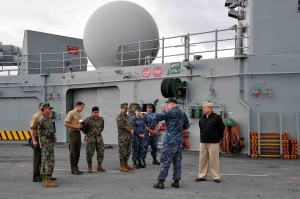2013-05-01 by Cpl. S. T. Stewart
ABOARD USS BATAAN, NAVAL STATION NORFOLK, Va
The international amphibious exercise, Bold Alligator 2013, concluded May 2.
Bold Alligator 13 was a Navy and Marine Corps-led synthetic exercise involving more than 3,500 personnel from 16 countries and Strike force NATO.
The exercise simulated a force of 16,000 Marines and Sailors embarked aboard 17 naval vessels.
The 11-day exercise was designed to improve the Navy and Marine Corps’ fundamental ability to integrate and execute large-scale operations from the sea. The Bold Alligator exercise series is an annual event, which began in 2011, that alternates between live and synthetic exercises.
In 2012 the exercise was live, with ships and embarked Marines and Sailors operating off the coast of North Carolina and Virginia.

This year’s exercise focused on integrating and streamlining staff planning, and command and control procedures of the Navy and Marine Corps teams from Expeditionary Strike Group 2, 2d Marine Expeditionary Brigade, and Carrier Strike Group 12. “I think the big advantage (of conducting a synthetic exercise) is that we have the opportunity to change the synthetic environment on a daily basis,” said Col. Bradley E. Weisz, deputy afloat commander of ESG 2.
“You have the ability to play back the opportunity to do the things you’re doing well, as well as the things you do not do so well. When you do it live, you get one shot and that’s it.”
The Marine Corps-Navy team normally conducts amphibious exercises at the Marine Expeditionary Unit and Amphibious Ready Group level.
The scale of this operation dwarfed the standard MEU-ARG team, which includes three amphibious assault ships with approximately 2,300 Marines and 2,000 Sailors embarked.
“This exercise was a way to improve the relationship between ESG-2 and 2d MEB,” said Weisz. “It’s also a way to improve the east coast’s relationship between Fleet Forces Command and (Marine Forces Command).” Military units at Marine Corps Bases Camp Lejeune and Camp Pendleton, Naval Air Station Oceana, and Naval Support Activity Hampton Roads all participated in different simulation centers. Working closely with their Marine and Sailor counterparts aboard USS Bataan was an international team consisting of personnel from Australia, New Zealand, Canada, France, Italy, Spain, the Netherlands, Brazil, Mexico, and Portugal and other countries.
“I feel BA 13 is important for the forces of Mexico and the United States to help with relations and gain experience,” said Jose Luis Santos Mujica, an officer in the Mexican Naval Infantry who participated as part of the coalition aboard USS Bataan. “This exercise is really important to us because we get to learn skills that we can use in future exercises with our country. We are very grateful for getting to be a part of BA 13, because it expands the bond between the U.S. and Mexico.
” This year’s exercise scenario involved coalition forces working to rid the fictional country of Amber from the invading aggressor country of Garnet.
During the scenario participants simulated ship-to-shore landings, coordinated continuous air support, and conducted maritime security operations while aggressively fighting their way through the fictional enemy forces on land.
While the participating ships remained in port during the exercise and no Marines were actually put ashore, there were multiple benefits and lessons learned from conducting the training.
“There are a lot of advantages to doing it here pier side,” said Weisz. “You can try new experiments, new initiatives and not have to waste a lot of the money and funds that you would have to use to get all the ships underway.
” Exercises such as Bold Alligator help prepare the Navy and Marine Corps team for future warfare conflicts, overseas contingency and crisis response operations. A big take-away from the exercise was the ability to try new methods in such a complex situation while addressing a challenge of getting the MEB/ESG command to think and operate as one team in the maneuver area.
“Conducting an operation of this magnitude in a real-life scenario takes a lot of coordination,” said Brig. Gen. John K. Love, commanding general of 2d MEB. “We participate in these (synthetic) exercises so when it comes to the real thing, we are proficient enough to accomplish our goal. Combining the synthetic events with live events is part of a training continuum that is essential in preparing us as an expeditionary crisis response force. We must be prepared when the call comes for us to head out.” The Navy-Marine Corps team will implement the lessons learned from this year when they participate in the live exercise, Bold Alligator 2014.
For our initial look at Bold Alligator 2013 based on interviews with the ESG 2 Commander and the MEF Commander see the following:
https://sldinfo.com/bold-alligator-2013-21st-century-flexibility-for-a-spectrum-of-missions/

